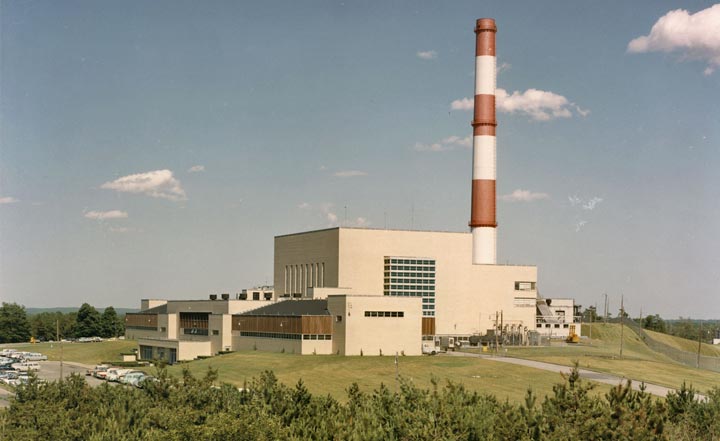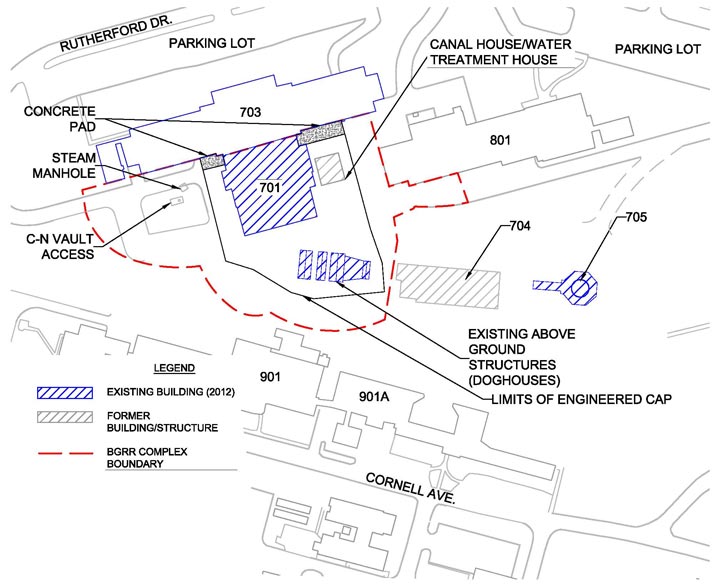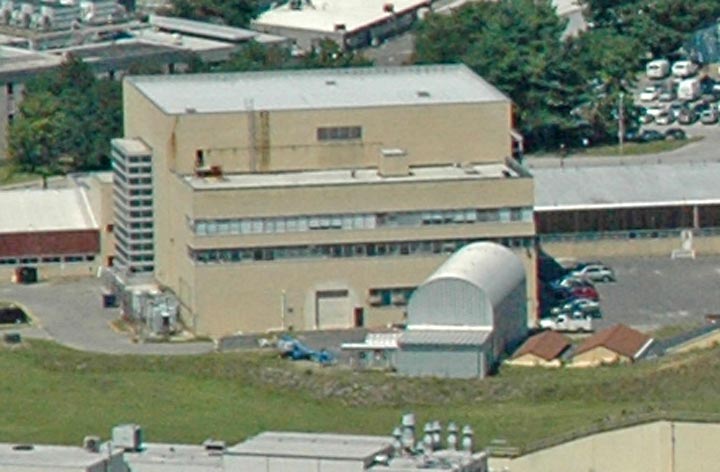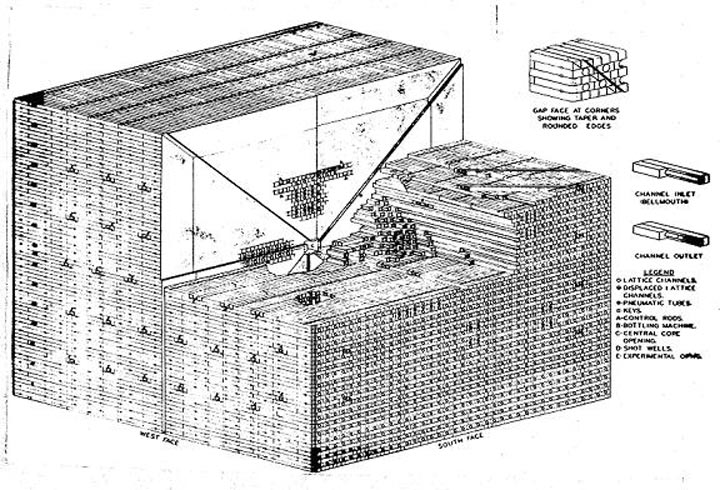Brookhaven Graphite Research Reactor Complex Description
Current HFBR Complex
The BGRR complex consists of multiple structures and systems that were necessary to operate and maintain the reactor. The most recognizable features of the complex include the Building 701 offices/high bay and the doghouse structures.
Portions of the complex building structures, systems, and components, some of which were underground, were contaminated with radionuclides and chemicals as a result of previous BGRR operations. The complex has been decommissioned during which a number of actions have been taken including the removal of contaminated structures, hazardous materials, and contaminated equipment and components. Additionally, an engineered cap was installed. The structures and systems, both current and former, are described below.
The BGRR complex includes Building 701; the Doghouses; the Engineered Cap; and the former Canal House/Water Treatment House. Buildings 704 (Fan House) and 705 (Stack) were structures that supported both the BGRR operations and HFBR operations. Descriptions and status of Buildings 704 and 705 are discussed under the HFBR website.
Complex Structures
The following provides an overview of the primary BGRR buildings and structures. Figure 1 provides an orientation of the BGRR complex, indicating both existing and former buildings that were once part of BGRR operations.

The Brookhaven Graphite Research Reactor (BGRR) is located in the central portion of the BNL property. The BGRR complex covers approximately 2 acres.


Building 701, Reactor Building - Existing
Building 701, or the Reactor Building, housed the former biological shield and graphite pile. The building was also used as administrative offices. The building is a riveted steel-frame structure with a multilayer brick exterior and covers a ground area of approximately 123 feet by 142 feet, and is 72 feet tall. It contains three floor levels plus the canal level below the main floor. Building 701 has been isolated to the extent possible from Building 703 and is currently vacant and in long-term storage.
Building 702 - Demolished
Building 702 was the designation for the graphite pile, biological shield, and associated equipment. Building 702 was entirely enclosed within Building 701 and has been demolished. Further descriptions are provided below under the Graphite Pile and Biological Shield sections.
Graphite Pile - Demolished
The graphite pile structure had the overall dimensions of a 25 foot cube. It was divided into two halves by a 3⅛ inch (8.0 cm) wide vertical gap. Seventy-five layers of 4 inch by 4 inch blocks of various lengths up to 45 inches were laid horizontally to form the graphite structure. Figure 2 shows an isometric cutaway view of the former graphite pile structure. The graphite pile has been dismantled and disposed of at an off-site facility.
A total of 1368 channels running north and south through the graphite carried the fuel assemblies and cooling air. There were 37 rows of 37 holes each, except for the center hole in the 18th row, which was occupied by a 12 inch square removable core. There were 30 experimental holes (5 rows of 6 holes each), each 4 inches square, which ran horizontally east–west through the graphite structure.
Cooling air drawn through roughing filters was pulled through the graphite to remove heat produced by the fuel and cool the graphite. The heated air then flowed out of the reactor into two underground concrete exhaust ducts connected to a plenum, then through in-duct filters and coolers. These concrete air ducts ran above ground over the roof of Building 704, which enclosed the large primary exhaust fans. The exhaust air then was drawn through these fans and discharged to a 100 meter high exhaust stack. The above ground portions of the air ducts have been dismantled and disposed of at an off-site facility.
Biological Shield - Demolished
The biological shield was 55 feet long by 37 feet, 6 inches wide by 33 feet, 7 inches high structure that surrounded the pile. The shield consisted of an inner layer of steel 6 inches thick (two separate plates in some areas), 4 feet, 3 inches of high-density concrete (with steel punchings and limonite iron ore), and an outer casing on the sides (but not on top) of 3 inches of steel plate. There was also a 12 inch thick by 20 inch wide belt of steel around the gap in the pile. The biological shield was designed to shield personnel working within Building 701 from radiation emitted from the pile. The image on left shows a cut-away diagram of the former biological shield. The biological shield has been dismantled and disposed of at an off-site facility.
Engineered Cap - Existing
The engineered cap is a water infiltration control and monitoring system to prevent water infiltration and the migration of residual contamination remaining in subsurface soil and underground concrete structures and is located to the west, east and south of the BGRR Building 701. The engineered cap covers an area of approximately 32,400 square feet and consists of a multi-layer barrier with the following layers from bottom to top:
- 3-inch thick sand protection layer;
- 40-mil high-density polyethylene (HDPE) liner;
- 12-inch thick sand protection layer;
- A geotextile liner;
- 2-inch thick crushed stone protection layer;
- 4-inch thick asphalt treated base (ATB) course; and
- 3-inch thick hot-mix asphalt surface course.
- Two concrete pads adjacent to the Building 701 east and west rollup doors.
Four groundwater monitoring wells were also installed around the engineered cap to monitor the effectiveness of the cap.
Doghouses - Existing
The doghouses are aboveground covered structures to the south of the BGRR Building 701. The doghouses were formerly building structures that were used in support of the BGRR operations and also supported the aboveground air ducts. The doghouses currently provide both access and cover to the below ground air ducts.
Yard
The yard area outside Building 701 is within the BGRR complex boundary as shown above in Figure 1. It consists of asphalt-paved and grass/dirt areas to the east, south, and west of Building 701.





